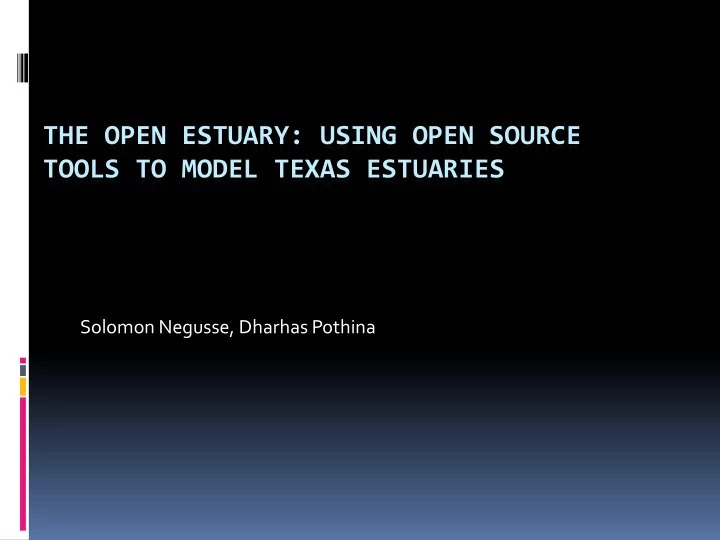

THE OPEN ESTUARY: USING OPEN SOURCE TOOLS TO MODEL TEXAS ESTUARIES Solomon Negusse, Dharhas Pothina
Modeling Bays and Estuaries Predictive modeling needs: Environmental flow needs Assisting navigation Oil spill Study impact of man made changes to the bays.
Hydrodynamic Model Numerical Formulation of Governing Equations
Hydrodynamic Model Numerical Formulation of Governing Equations
Hydrodynamic Model Numerical Formulation of Governing Equations
Hydrodynamic Model Numerical Formulation of Governing Equations
Hydrodynamic Model Numerical Formulation of Governing Equations Water level, velocity, salinity temperature prediction at computational elements
Selfe Model Applications An open source hydrodynamic code written in fortran. Solves 3D physical variables(Free surface elevation, velocity), Temperature & Salinity Coded with mpi and run on in‐house HPC cluster Finite element model – run on unstructured triangular mesh
SELFE Model work flow
Computation Grid Generation Surface Modeling Systems software
Computation Grid Generation Good resolution control, grid modification tools. Nice user friendly Interface (kind of). Still a lot of limitations: available for windows os only, crashes a lot, doesn’t handle big grids well. Interpolation of bathymetry on to grid not efficient
Interpolation in SMS
Anisotropic stretched IDW interpolation in python
Stretched Anisotropic IDW in SMS Interpolation w/ Python
More input file processing Pwl_interp.py Usgsflow_interp.py 2dm2gr3.py
Output Processing and Visualization Pyselfe: python class for model output storage and access.
Output Processing and Visualization Matplotlib 2d plots.
Field data for Calibration and Validation Python INstrumentationToolkit (PINT): putting data to common format Pyhis : access timeseries data on the web from different sources
Output Processing and Visualization Selfe2tec2D.py Converts data to structured data format.
Conclusion and feature goals Efficiency has improved through automation Improved accuracy Enhanced visualization capability Goals: ‐ visualization with Mayavi, viSit, ‐ Making codes available for contribution ‐ Generic code structure with ability to write translators for other hydro models inputs
Recommend
More recommend